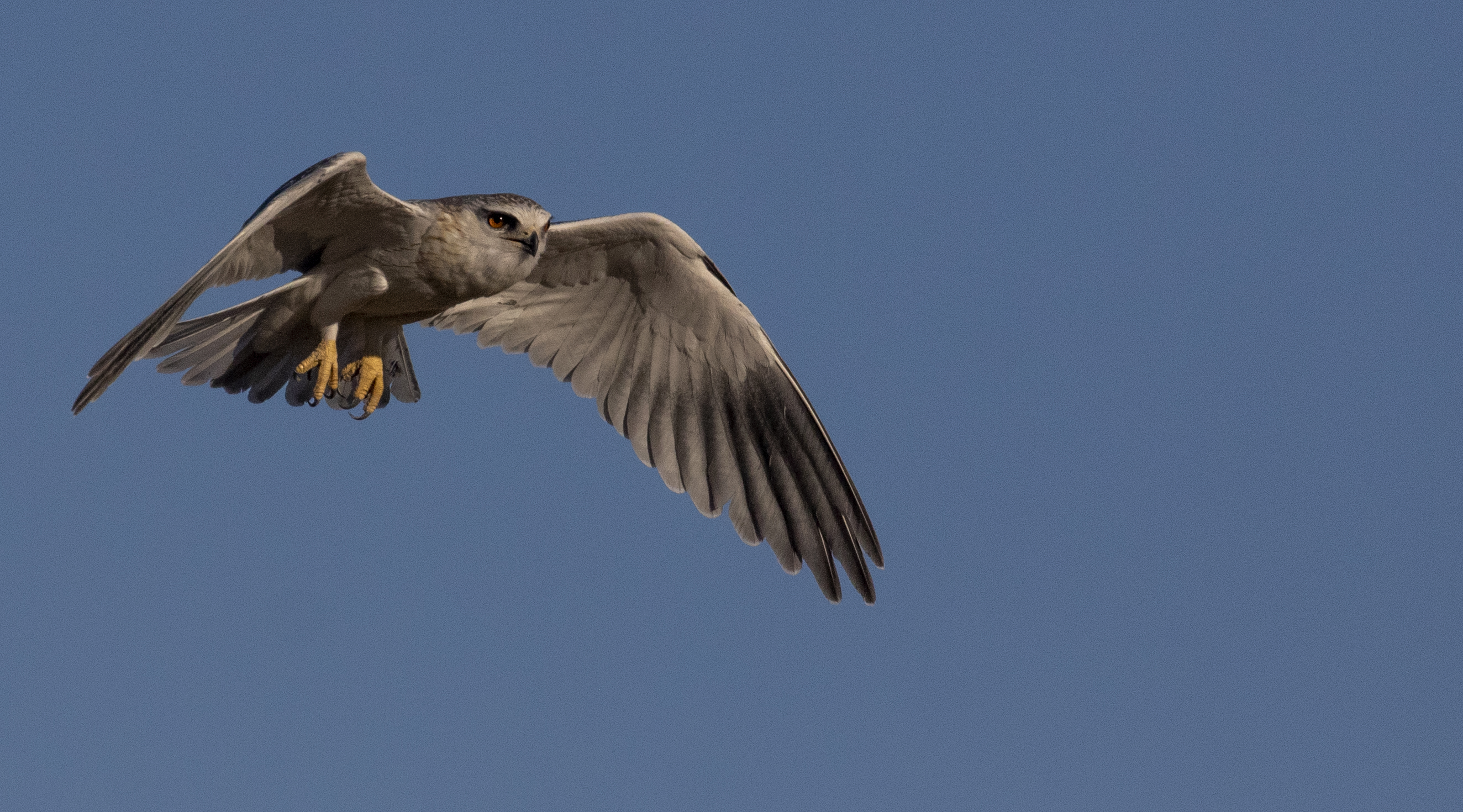Black-winged Kite (Elanus caeruleus)
CAR summary data
Habitat and noted behaviour
Sightings per Kilometre
Please note: The below charts indicate the sightings of individuals along routes where the species has occured, and NOT across all routes surveyed through the CAR project.
Global Status

IUCN Data (Global)
IUCN 2024. IUCN Red List of Threatened Species. Version 2024-1 (www)Assessment year: 2022
Assessment Citation
Westrip, J.R.S. & BirdLife International 2022. Elanus caeruleus (Mediterranean assessment). The IUCN Red List of Threatened Species 2022: e.T22695028A210511024. Accessed on 07 January 2026.Geographic range:
In the Mediterranean, the species breeds primarily in Portugal and Spain (in Europe) and Morocco, Tunisia and Algeria (in North Africa), with very small populations also in Turkey, France and Egypt. The species does also breed in the Middle East.Habitats:
This species is widely distributed across the Afrotropical and Indomalayan regions, with marginal occurrence in the Western Palearctic (Ferguson-Lees and Christie 2001). Numbers are increasing in Iberia (Snow and Perrins 1998), coinciding with the clearance of oak woodlands and understory vegetation (Shirihai et al. 2000). The species is generally sedentary, with some movements to more open habitats during winter (Snow and Perrins 1998). Juveniles will generally disperse from natal grounds. It occupies relatively open habitats at a range of altitudes, ranging from semi-desert to forest margins and clearings within densely forested areas. It is generally absent in continuous forest tracts and steep mountainous areas and will opportunistically use areas cleared after fires (Snow and Perrins 1998). In the non-breeding season, it forms communal roosts in trees or reed beds, with birds dispersing to individual territories during the day (del Hoyo et al. 1994).The species’ prey comprises small grassland mammals (up to 90 g), reptiles, birds and insects, hunting its quarry from both a perch and hovering vantage, as well as quartering the ground and hawking insects in flight. It will often hunt during dawn and dusk (del Hoyo et al. 1994).
Nests are made of small twigs lined with finer material, and are located in tree branches 3-20 m above the ground, usually in open areas (del Hoyo et al. 1994). The same tree may be occupied in successive years, although new nests are usually built each year. The breeding season spans February to August (Ferguson-Lees and Christie 2001). It is able to exploit disturbed or cleared areas and increase its breeding productivity under favourable prey conditions.
Population:
The entirety of the Spanish, Portuguese, Algerian and Turkish populations fall within the Mediterranean region, and virtually the entirety of the Moroccan and Tunisian populations do too. Therefore, it is only the Egyptian and French populations where the majority of the mapped range falls outside of the Mediterranean region. A minimum population estimate could therefore be estimated using the Spanish, Portuguese, Algeria, Turkish, Moroccan and Tunisian population sizes (4,810-7,620 mature individuals; see Garrido et al. 2021 and BirdLife International 2021). To take into account the population in the Middle East of unknown size, the small parts of the French and Egyptian populations that do fall in the region, and the fact that a very small part of the Moroccan and Tunisian mapped range falls outside of the region, a slightly broader population size range is used here, 4,750-8,000 mature individuals. The population size is considered to be stable in Europe, and increasing in North Africa, so overall the population trend is considered to be increasing in the region.Threats:
There are no major threats to the species within its range (Kemp et al. 2015), but locally, it may be threatened by the use of rodenticides and pesticides (Ferguson-Lees and Christie 2001). It may also be killed for predator control (Brochet et al. 2016).Conservation measures:
Conservation Actions UnderwayThe species is listed on Annex II of the Bern Convention. It occurs within a number of protected areas across its range.
Conservation Actions Proposed
It is recommended to undertake more research on the species in the North African part of the region, especially for young researchers and due to its accessibility.
Rationale:
Mediterranean regional assessment: Least Concern (LC)This species has a very large range (its extent of occurrence (EOO) is larger than 20,000 km² and its area of occupancy (AOO) is much larger than 2,000 km²), and hence it does not approach the thresholds for Vulnerable under the range size criteria (criteria B and D2). The population size is small (<10,000 but >1,000 mature individuals), but the population trend is estimated to be increasing, and hence it does not approach the thresholds for Vulnerable under the population size criteria (criteria C and D) or the population size reduction criterion (criterion A). The probability of extinction has not been calculated for this species, therefore criterion E cannot be applied. For these reasons the species is evaluated as Least Concern.
 Login
Login



